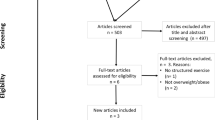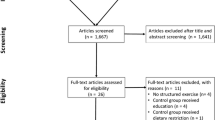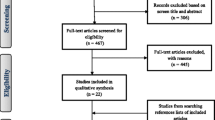Abstract
Adolescent obesity has increased dramatically in several countries in recent decades; however, the contribution of physical activity level to adolescent adiposity requires clarification. This article investigates the effect of physical activity on subsequent levels of adiposity in adolescence. The methodological aspects of the studies included in this article, particularly in terms of measurement accuracy for both exposure (physical activity) and outcome (adiposity) variables, are also evaluated. Systematic searches of the literature were undertaken using online databases, including PubMed/MEDLINE, examination of citations and contacting of authors. The online databases were searched from their earliest records until 2007. Only longitudinal studies with 50 or more adolescents were included. Two independent reviewers assessed the quality of the studies using the Downs and Black checklist. Thirteen observational, five experimental and six quasi-experimental studies (without a control group) were identified. Almost all studies were carried out in high-income settings and showed protective effects of physical activity for both prevention and treatment of adolescent obesity. However, experimental studies undertaken with obese adolescents at baseline usually combined physical activity with dietary changes, making it difficult to assess the effect of physical activity itself on the treatment of obesity. Physical activity estimated from questionnaires and body mass index (BMI) were the most frequently used measures. Despite the feasibility of using these approaches in epidemiological studies, significant limitations are evident. Questionnaires are subjective and adolescents may not report physical activity level accurately. Furthermore, BMI is not an accurate measure of fatness for adolescents, as it is also associated with lean mass, hence bias may arise from its longitudinal association with physical activity level. Despite the majority of studies reviewed showing protective effects of physical activity on adiposity, particularly in individuals who are obese at baseline, the current literature on this issue is sparse and several methodological drawbacks are evident. The main limitations relate to a lack of validity in the measurements of both physical activity and body composition. Further studies are needed in order to generate evidence-based recommendations for the quantity and quality of adolescent physical activity required to prevent or treat adolescent obesity.






Similar content being viewed by others
References
Wang Y, Monteiro C, Popkin BM. Trends of obesity and underweight in older children and adolescents in the United States, Brazil, China, and Russia. Am J Clin Nutr 2002 Jun; 75 (6): 971–7
da Veiga GV, da Cunha AS, Sichieri R. Trends in overweight among adolescents living in the poorest and richest regions of Brazil. Am J Public Health 2004 Sep; 94 (9): 1544–8
Wyatt SB, Winters KP, Dubbert PM. Overweight and obesity: prevalence, consequences, and causes of a growing public health problem. Am J Med Sci 2006 Apr; 331 (4): 166–74
Thomsen SF, Ulrik CS, Kyvik KO, et al. Association between obesity and asthma in a twin cohort. Allergy 2007 Oct; 62 (10): 1199–204
Smith Jr SC. Multiple risk factors for cardiovascular disease and diabetes mellitus. Am J Med 2007 Mar; 120(3 Suppl. 1): S3–11
Ko GT, Chan JC, Chan AW, et al. Association between sleeping hours, working hours and obesity in Hong Kong Chinese: the ‘better health for better Hong Kong’ health promotion campaign. Int J Obes 2007 Feb; 31 (2): 254–60
Gold DR, Damokosh AI, Dockery DW, et al. Body-mass index as a predictor of incident asthma in a prospective cohort of children. Pediatr Pulmonol 2003 Dec; 36 (6): 514–21
Scott KM, Bruffaerts R, Simon GE, et al. Obesity andmental disorders in the general population: results from the world mental health surveys. Int J Obes 2008 Jan; 32 (1): 192–200
Janssen I, Katzmarzyk PT, Boyce WF, et al. Overweight and obesity in Canadian adolescents and their associations with dietary habits and physical activity patterns. J Adolesc Health 2004 Nov; 35 (5): 360–7
Levin S, Lowry R, Brown DR, et al. Physical activity and body mass index among US adolescents: youth risk behavior survey, 1999. Arch Pediatr Adolesc Med 2003 Aug; 157 (8): 816–20
Ekelund U, Neovius M, Linne Y, et al. Associations between physical activity and fat mass in adolescents: the Stockholm Weight Development Study. Am J Clin Nutr 2005 Feb; 81 (2): 355–60
Gazzaniga JM, Burns TL. Relationship between diet composition and body fatness, with adjustment for resting energy expenditure and physical activity, in preadolescent children. Am J Clin Nutr 1993 Jul; 58 (1): 21–8
Connelly JB, Duaso MJ, Butler G. A systematic review of controlled trials of interventions to prevent childhood obesity and overweight: a realistic synthesis of the evidence. Public Health 2007 Jul; 121 (7): 510–7
Doak CM, Visscher TL, Renders CM, et al. The prevention of overweight and obesity in children and adolescents:a review of interventions and programmes. Obes Rev 2006 Feb; 7 (1): 111–36
Must A, Tybor DJ. Physical activity and sedentary behavior: a review of longitudinal studies of weight and adiposity inyouth. Int J Obes 2005 Sep; 29 Suppl. 2: S84–96
Downs SH, Black N. The feasibility of creating a checklist for the assessment of the methodological quality both of randomised and non-randomised studies of health care interventions. J Epidemiol Commun Health 1998 Jun; 52 (6): 377–84
Monteiro PO, Victora CG. Rapid growth in infancy and childhood and obesity in later life: a systematic review. Obes Rev 2005 May; 6 (2): 143–54
Eliakim A, Kaven G, Berger I, et al. The effect of a combined intervention on body mass index and fitness in obese children and adolescents: a clinical experience. Eur J Pediatr 2002 Aug; 161 (8): 449–54
Gutin B, Barbeau P, Owens S, et al. Effects of exercise intensity on cardiovascular fitness, total body composition, and visceral adiposity of obese adolescents. Am J Clin Nutr 2002 May; 75 (5): 818–26
McMurray RG, Harrell JS, Bangdiwala SI, et al. A school-based intervention can reduce body fat and blood pressure in young adolescents. J Adolesc Health 2002 Aug; 31 (2): 125–32
Savoye M, Shaw M, Dziura J, et al. Effects of a weight management program on body composition and metabolic parameters in overweight children: a randomized controlled trial. JAMA 2007 Jun 27; 297 (24): 2697–704
Gortmaker SL, Peterson K, Wiecha J, et al. Reducing obesity via a school-based interdisciplinary intervention among youth: Planet Health. Arch Pediatr Adolesc Med 1999 Apr; 153 (4): 409–18
Dao HH, Frelut ML, Oberlin F, et al. Effects of a multidisciplinary weight loss intervention on body composition in obese adolescents. Int J Obes Relat Metab Disord 2004 Feb; 28 (2): 290–9
Reinehr T, Brylak K, Alexy U, et al. Predictors to success in outpatient training in obese children and adolescents. Int J Obes Relat Metab Disord 2003 Sep; 27 (9): 1087–92
Reinehr T, Temmesfeld M, Kersting M, et al. Four-year follow-up of children and adolescents participating in an obesity intervention program. Int J Obesity (2005) 2007 Jul; 31 (7): 1074–7
Sothern, Udall Jr JN, Suskind RM, et al. Weight loss and growth velocity in obese children after very low calorie diet,exercise, and behavior modification. Acta Paediatr 2000 Sep; 89 (9): 1036–43
Sothern MS, von Almen TK, Schumacher HD, et al. A multidisciplinary approach to the treatment of childhood obesity. Del Med J 1999 Jun; 71 (6): 255–61
Wong ML, Koh D, Lee MH, et al. Two-year follow-up of a behavioural weight control programme for adolescents in Singapore: predictors of long-term weight loss. Ann Acad Med Singapore 1997 Mar; 26 (2): 147–53
Berkey CS, Rockett HR, Field AE, et al. Activity, dietary intake, and weight changes in a longitudinal study of pre-adolescent and adolescent boys and girls. Pediatrics 2000 Apr; 105 (4): E56. doi:10.1542/peds.105.4.e56
Berkey CS, Rockett HR, Gillman MW, et al. One-year changes in activity and in inactivity among 10- to 15-year-old boys and girls: relationship to change in body mass index. Pediatrics 2003 Apr; 111 (4 Pt 1): 836–43
Elgar FJ, Roberts C, Moore L, et al. Sedentary behaviour, physical activity and weight problems in adolescents in Wales. Public Health 2005 Jun; 119 (6): 518–24
Heelan KA, Donnelly JE, Jacobsen DJ, et al. Active commuting to and from school and BMI in elementary school children: preliminary data. Child Care Health Dev 2005 May; 31 (3): 341–9
Kettaneh A, Oppert JM, Heude B, et al. Changes in physical activity explain paradoxical relationship between baseline physical activity and adiposity changes in adolescent girls: the FLVS II study. Int J Obes 2005 Jun; 29 (6): 586–93
Kimm SY, Glynn NW, Obarzanek E, et al. Relation between the changes in physical activity and body-mass index during adolescence: a multicentre longitudinal study. Lancet 2005 Jul 23-29; 366 (9482): 301–7
Mo-suwan L, Tongkumchum P, Puetpaiboon A. Determinants of overweight tracking from childhood to adolescence:a 5 y follow-up study of Hat Yai school children. Int J Obes Relat Metab Disord 2000 Dec; 24 (12): 1642–7
Mundt CA, Baxter-Jones AD, Whiting SJ, et al. Relationships of activity and sugar drink intake on fat mass development in youths. Med Sci Sports Exerc 2006 Jul; 38 (7): 1245–54
Must A, Bandini LG, Tybor DJ, et al. Activity, inactivity, and screen time in relation to weight and fatness over adolescence in girls. Obesity (Silver Spring) 2007 Jul; 15 (7): 1774–81
O’Loughlin J, Gray-Donald K, Paradis G, et al. One and two-year predictors of excess weight gain among elementary school children in multiethnic, low-income, inner-city neighborhoods. Am J Epidemiol 2000 Oct 15; 152 (8): 739–46
Rosenberg DE, Sallis JF, Conway TL, et al. Active transportation to school over 2 years in relation to weight status and physical activity. Obesity (Silver Spring) 2006 Oct; 14 (10): 1771–6
Stice E, Presnell K, Shaw H, et al. Psychological and behavioral risk factors for obesity onset in adolescent girls:a prospective study. J Consult Clin Psychol 2005 Apr; 73 (2): 195–202
Wardle J, Brodersen NH, Boniface D. School-based physical activity and changes in adiposity. Int J Obes 2007 Sep; 31 (9): 1464–8
Rafferty AP, Reeves MJ, McGee HB, et al. Physical activity patterns among walkers and compliance with public health recommendations. Med Sci Sports Exerc 2002 Aug; 34 (8): 1255–61
Hallal PC, Azevedo MR, Reichert FF, et al. Who, when, and how much? Epidemiology of walking in a middle-income country. Am J Prev Med 2005 Feb; 28 (2): 156–61
Salles-Costa R, Heilborn ML, Werneck GL, et al. Gender and leisure-time physical activity [in Portuguese]. Cad Saude Publica 2003; 19 Suppl. 2: S325–33
Gal DL, Santos AC, Barros H. Leisure-time versus full-day energy expenditure: a cross-sectional study of sedentarism in a Portuguese urban population. BMC Public Health 2005 Feb 15; 5: 16. doi:10.1186/1471-2458-5-16
Wells JC, Fuller NJ, Dewit O, et al. Four-component model of body composition in children: density and hydration offat-free mass and comparison with simpler models. Am J Clin Nutr 1999 May; 69 (5): 904–12
Williams JE, Wells JC, Wilson CM, et al. Evaluation of lunar prodigy dual-energy x-ray absorptiometry for assessing body composition in healthy persons and patients by comparison with the criterion 4-component model. Am J Clin Nutr 2006 May; 83 (5): 1047–54
Wong WW, Hergenroeder AC, Stuff JE, et al. Evaluating body fat in girls and female adolescents: advantages and disadvantages of dual-energy x-ray absorptiometry. Am J Clin Nutr 2002 Aug; 76 (2): 384–9
Wells JC. A Hattori chart analysis of body mass index in infants and children. Int J Obes Relat Metab Disord 2000 Mar; 24 (3): 325–9
Torun B, Viteri FE. Influence of exercise on linear growth. Eur J Clin Nutr 1994 Feb; 48 Suppl. 1: S186–S189
Lara Fernandez A, Escolar Castellon JL, Aguilar Cuevas R, et al. Obesity and distribution of body fat: correlation between anthropometric and tomographic data on areas at the abdominal level [in Spanish]. Rev Clin Esp 1996 Jul; 196 (7): 437–45
Rosin BL. The progression of cardiovascular risk to cardiovascular disease. Rev Cardiovasc Med 2007; 8 Suppl. 4: S3–8
Wells JC, Coward WA, Cole TJ, et al. The contribution of fat and fat-free tissue to body mass index in contemporary children and the reference child. Int J Obes Relat Metab Disord 2002 Oct; 26 (10): 1323–8
Wells JC. A critique of the expression of paediatric body composition data. Arch Dis Child 2001 Jul; 85 (1): 67–72
Wells JC, Victora CG. Indices of whole-body and central adiposity for evaluating the metabolic load of obesity. Int J Obes 2005 May; 29 (5): 483–9
Rennie KL, Wells JC, McCaffrey TA, et al. The effect of physical activity on body fatness in children and adolescents. Proc Nutr Soc 2006 Nov; 65 (4): 393–402
Ness AR, Leary SD, Mattocks C, et al. Objectively measured physical activity and fat mass in a large cohort of children. Plos Med 2007 Mar; 4 (3): e97. doi:10.1371/journal.pmed.0040097
Sirard JR, Pate RR. Physical activity assessment in children and adolescents. Sports Med 2001; 31 (6): 439–54
Rowlands AV. Accelerometer assessment of physical activity in children: an update. Pediatr Exerc Sci 2007; 19: 252–66
Biddle S, Cavill N, Sallis J. Young and active? Young people and health-enhancing physical activity: evidence and implications. London: Health Education Authority, 1998
Twisk JW. Physical activity guidelines for children and adolescents: a critical review. Sports Med 2001; 31 (8): 617–27
Buscemi N, Vandermeer B, Hooton N, et al. Efficacy and safety of exogenous melatonin for secondary sleep disorders and sleep disorders accompanying sleep restriction:meta-analysis. BMJ (Clin Res Ed) 2006 Feb 18; 332 (7538): 385–93
Machado M, Bajcar J, Guzzo GC, et al. Sensitivity of patient outcomes to pharmacist interventions: part I. Systematic review and meta-analysis in diabetes management. Ann Pharmacother 2007 Oct; 41 (10): 1569–82
Teasell R, Bayona N, Marshall S, et al. A systematic review of the rehabilitation of moderate to severe acquired brain injuries. Brain Inj 2007 Feb; 21 (2): 107–12
Acknowledgements
Felipe F. Reichert thanks the National Council of Technological and Scientific Development (CNPq) for supporting him with an academic scholarship during the writing of the manuscript. No other sources of funding were used to assist in the preparation of this review. The authors do not have any conflicts of interest that are relevant to the contents of this manuscript.
Author information
Authors and Affiliations
Corresponding author
Rights and permissions
About this article
Cite this article
Reichert, F.F., Menezes, A.M.B., Wells, J.C.K. et al. Physical Activity as a Predictor of Adolescent Body Fatness. Sports Med 39, 279–294 (2009). https://doi.org/10.2165/00007256-200939040-00002
Published:
Issue Date:
DOI: https://doi.org/10.2165/00007256-200939040-00002




